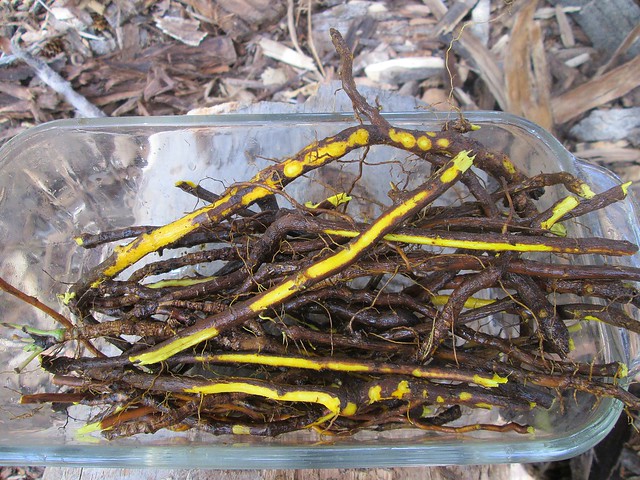|
|
Post by felicia on Nov 18, 2013 11:22:32 GMT -6
Can you provide instructions for making berberine solution ?
|
|
|
|
Post by FOTH on Nov 18, 2013 16:35:47 GMT -6
Yes, I can.  Here's an excerpt from my article on Rocky Mountains Medicinal Plants, which I've posted in the medicinal plants section of this forum, with some additional information: Oregon grape Mahonia repens Roots will effectively eliminate the cause of most cases of bacterial diarrhea (E. coli, Shigella, Salmonella and cholera, to name a few...) Kills strep and staph bacteria, and is effective against most intestinal parasites. Several controlled studies have shown berberine, the alkaloid that gives the roots their distinctive yellow color, to be more effective than metronidazole (Flagyl) in eliminating Giardia, without the bad side effects. You’ll need to drink a strong tea of it several times a day for three or four days for this to be effective. If your hands or feet start tingling or going numb, you are getting too much. It also makes a very effective wash for eye infections and irritations. Berberine is water soluble, so this can be done as a tea. It tastes awful, but does the job. What you want are the brightest yellow parts of the root, which usually means the inner bark, but you can just break up the entire root and toss it in the pot. If one has time, the solution can be made by washing and breaking up the roots, then letting them steep in water in a sunny windowsill--like sun tea. The batch in the photo above was made by soaking the roots in water for an entire day, in the sun. A quicker job can be done by gently simmering the broken roots in water, then filtering to remove root bark and other plant matter. If you have any other questions, please let me know. Here are some washed and chopped roots from a batch of berberine I made earlier this year:   |
|
|
|
Post by felicia on Nov 18, 2013 16:49:15 GMT -6
How long can the tea be stored ?
Store in a refrigerator ?
Are the berries safe to eat ? If yes do they make good jelly & jam ?
|
|
|
|
Post by FOTH on Nov 19, 2013 16:19:02 GMT -6
Felicia, yes, the berries are edible! They're quite lemony and tart, so most people like to add some sugar or honey when making jam or jelly, but they have a wonderful taste, and I enjoy snacking on them when out hiking in the fall. This was a very good year for berries of all sorts here in my area, and I made many jars of Oregon grape jam and syrup for the winter.
The tea should be refrigerated, yes, if you're not going to use it within a few days, and is still useful after several months of storage when kept that way.
Do you have Oregon grapes in your area?
|
|
|
|
Post by felicia on Nov 19, 2013 18:41:23 GMT -6
I have not seen Oregon Grape growing in West Virginia where I live, I hope to add some bushes next spring.
|
|
|
|
Post by dravine on Aug 12, 2015 19:08:59 GMT -6
Would Berberis roots be a suitable substitute for Oregon Grape roots where they are not abundant or found within the region?
- Jesse
|
|
|
|
Post by FOTH on Aug 12, 2015 21:06:10 GMT -6
Jesse, good to see you here!
Both berberis and Oregon grape, mahonia, are in the Barberry/Berberidaceae family, and chemically, the roots are somewhat similar. The berberine content is going to vary by species, but as far as I know, all species of berberis will have a useful amount in the roots and stems, and would work for making the solution.
|
|
|
|
Post by dravine on Aug 13, 2015 9:14:26 GMT -6
Thanks for the clarification and the warm welcome! Been away from the overall community for a while due to heavy work loads the past few years. Very nice to be getting involved again  - Jesse |
|